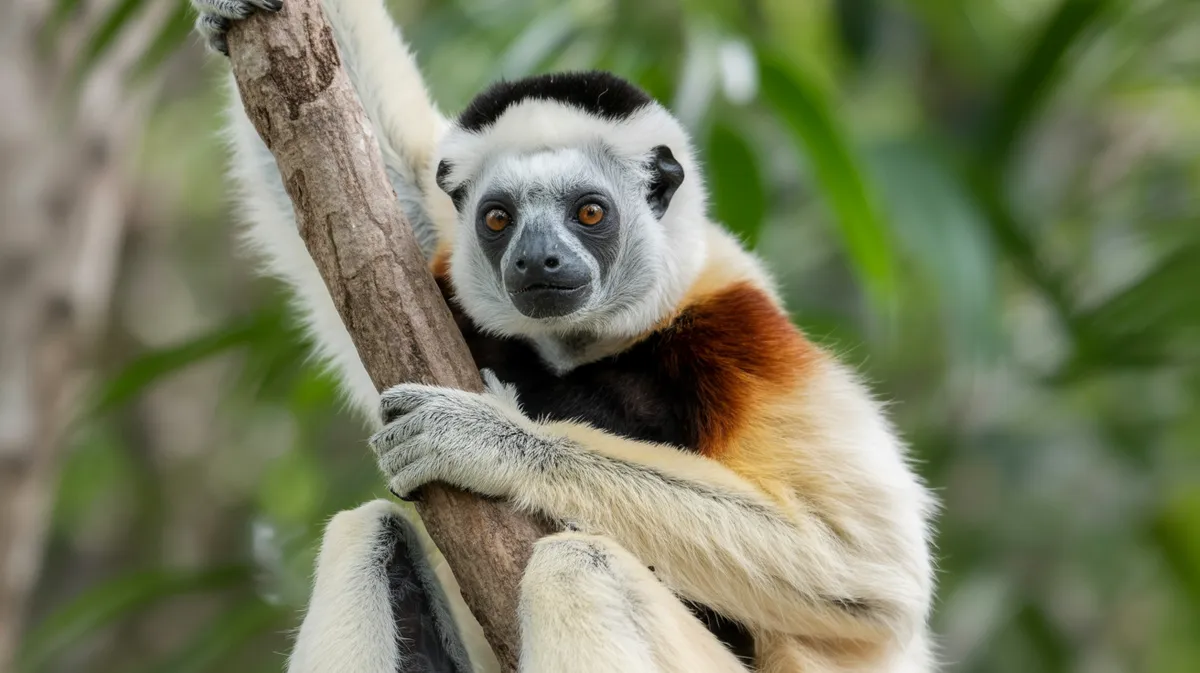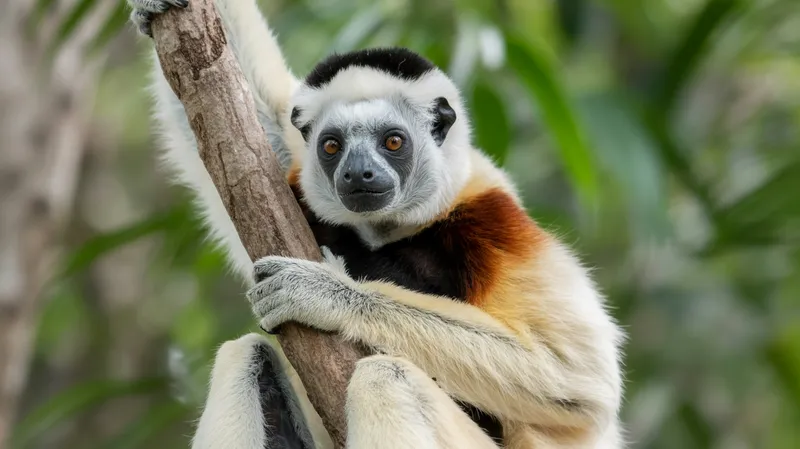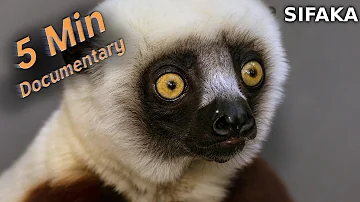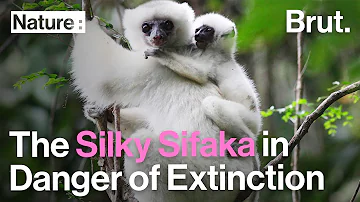
Sifaka
Propithecus verreauxi

Meet the Sifaka
The sifaka is a group of lemurs known for their striking appearance and distinctive mode of locomotion, characterized by upright leaping between trees. Native exclusively to Madagascar, they have dense, silky fur that varies from white to golden with contrasting patches. Sifakas are highly social, living in small groups dominated by females, and communicate through a variety of vocalizations and body language. Their specialized diet and arboreal lifestyle make them highly adapted to Madagascar's forests, but also vulnerable to habitat loss.
Classification
Mammal
Habitat
Dry deciduous forest
Diet
Herbivore
Lifespan
18-25 years
Conservation
Endangered
Weight
3-6 kg
📖Fascinating Facts
Tree Hoppers
Sifakas are famous for their powerful leaping abilities, often covering distances of up to 10 meters between tree trunks using only their hind legs.
Female-Led Groups
Sifaka social groups are led by dominant females, a rare trait among primates, and group members cooperate in raising young and defending territory.
Specialized Diet
Sifakas feed mainly on leaves, flowers, fruit, and bark, relying on Madagascar's diverse plant life and playing a key role in seed dispersal.
📋Detailed Description
Sifakas (genus Propithecus) are medium-sized lemurs distinguished by their long, powerful hind limbs, which facilitate their unique mode of vertical clinging and leaping locomotion. Adults typically measure 40–55 cm in body length, with tails nearly as long as their bodies (45–60 cm), and weigh between 3 and 6 kg depending on the species. Their dense, silky fur varies in color from creamy white to golden, with contrasting dark patches on the chest, limbs, or face; for example, Verreaux’s sifaka (Propithecus verreauxi) is predominantly white with dark patches on the sides and limbs. Sifakas possess a small, rounded head, large forward-facing eyes adapted for stereoscopic vision, and a short, blunt snout. They are highly arboreal, rarely descending to the ground, and are renowned for their spectacular leaps of up to 10 meters between tree trunks. Socially, sifakas live in cohesive groups of 2–13 individuals, typically led by a dominant female, exhibiting matriarchal social structures. Their vocal repertoire is complex, including the characteristic 'shi-fak' alarm call, as well as contact, warning, and territorial calls. Sifakas are diurnal, spending most of their day foraging, resting, and engaging in social grooming. Their diet is primarily folivorous, supplemented by fruits, flowers, and seeds, and they play a critical role in seed dispersal within Madagascar’s forests.
💡 Did you know?
The word 'sifaka' comes from the animal's distinctive 'shi-fak' alarm call.
🔬Research & Sources
Wikipedia Summary
A sifaka is a lemur of the genus Propithecus from the family Indriidae within the order Primates. The common name is an onomatopoeia of their characteristic "shi-fak" alarm call. Like all lemurs, they are found only on the island of Madagascar. All species of sifakas are threatened, ranging from endangered to critically endangered.
Last Modified: 1/16/2025
🎭Behavior & Social Structure
Sifakas are strictly diurnal, with activity peaking in the early morning and late afternoon. Their daily routine involves foraging for leaves, buds, flowers, and fruit, with occasional ingestion of bark and soil for mineral supplementation. Sifakas exhibit a highly specialized form of locomotion known as vertical clinging and leaping: they cling upright to tree trunks and propel themselves laterally with powerful jumps, using their long hind limbs. On the ground, they move bipedally in a characteristic sideways hopping gait. Social interactions are frequent and include grooming, play, and vocal communication. Group cohesion is maintained through contact calls and scent marking, with both sexes possessing specialized scent glands. Aggression is rare but may occur during intergroup encounters or over food resources. Sifakas are territorial, and home ranges can overlap, but core areas are defended through vocalizations and scent marking.
👶Reproduction & Life Cycle
Sifakas have a seasonal breeding pattern, with mating typically occurring between January and March, coinciding with the rainy season. Females are receptive for only a few days each year, and competition among males for access to females can be intense. Following a gestation period of approximately 130–140 days, a single offspring is born, usually between June and July. Infants cling to the mother’s belly for the first 3–4 weeks, then ride on her back as they grow. Weaning occurs at around 5–6 months, but juveniles remain dependent on their mothers for up to a year. Female sifakas reach sexual maturity at 2.5–3.5 years, while males mature slightly later. Parental care is primarily provided by the mother, though alloparenting by other group members, especially older siblings, is common.
🛡️Adaptations & Survival
Sifakas exhibit several remarkable adaptations for arboreal life. Their elongated hind limbs and reduced thumbs facilitate powerful leaping and a strong grip on vertical supports. The tail, though not prehensile, aids in balance during leaps. Their digestive system is adapted to a folivorous diet, with an enlarged cecum and colon for fermenting fibrous plant material. Sifakas have a highly developed sense of smell, used for communication and detecting food. Socially, their matriarchal structure and complex vocalizations are adaptations to group living in dense forests. Their seasonal reproductive cycle is synchronized with periods of food abundance, maximizing offspring survival.
📚Research Sources
🎨Cultural Significance
Sifakas hold an important place in Malagasy culture and folklore. In some regions, they are considered sacred (fady) and are protected by traditional taboos, which can aid in their conservation. Sifakas are also featured in local myths and stories, often symbolizing agility, cleverness, or the spirit of the forest. Ecotourism centered on sifaka viewing provides economic incentives for habitat protection in some areas, though benefits are unevenly distributed.
🔬Recent Research & Discoveries
Recent research has focused on the genetic diversity and phylogeography of sifaka populations, revealing significant genetic structuring even between nearby forest fragments. Long-term field studies, such as those at Beza Mahafaly Special Reserve, have provided insights into sifaka social dynamics, reproductive strategies, and responses to environmental change. Studies on their vocal communication have demonstrated context-specific calls and potential dialects between populations. Ongoing research is investigating the impacts of habitat fragmentation on health, behavior, and gene flow, as well as the effectiveness of community-based conservation initiatives.
🎥Wildlife Videos

Wild Madagascar - Fantastic Creatures | Free Documentary Nature
Wild Madagascar - Fantastic Creatures | Free Documentary Nature Watch 'Trouble in Paradise - The Last Lemurs of Madagascar ...
Free Documentary - Nature

Sifaka Lemurs Make A Treacherous Journey For Food | BBC Earth
Taken from Earth's Tropical Islands episode 1 'Madagascar' Three iconic islands. Madagascar. Borneo. Hawaii. Each a contained ...
BBC Earth

Sifaka - 5 Minute Documentary
Embark on an extraordinary wildlife odyssey with a captivating five-minute documentary that unveils the fascinating world of the ...
Five Minute Documentaries

Sifaka Lemurs Jumping Around | Attenborough | BBC Earth
From the BBC's Life of Mammals documentary series. WATCH MORE: New on Earth: https://bit.ly/2M3La96 Oceanscapes: ...
BBC Earth

The Silky Sifaka, a Lemur in Critical Danger of Extinction
This white lemur is one of the most endangered species in the world. Meet the silky sifaka. Subscribe to Brut America: ...
Brut America

Sifakas of Madagascar (Primates) - PREVIEW
Purchase: http://www.der.org/films/sifakas-of-madagascar.html Two very closely related species of sifaka are compared in this ...
Documentary Educational Resources
🌍Habitat Information
The Sifaka typically inhabits Dry deciduous forest environments. Sifakas have adapted to their environments with specialized features and behaviors.
Primary Habitat:
Dry deciduous forest
More detailed habitat information will be available soon.
🛡️Conservation Status
The Sifaka is currently classified as Endangered. Conservation efforts are crucial for preserving this species for future generations.
Common Threats:
- 🏠Habitat loss and fragmentation
- 🌡️Climate change impacts
- 🎯Hunting and poaching
- 🏭Human-wildlife conflict
⚠️Threats & Conservation Challenges
All sifaka species face significant threats, primarily from habitat loss due to slash-and-burn agriculture (tavy), logging, and charcoal production. Fragmentation of forest habitats isolates populations, reducing genetic diversity and increasing vulnerability to stochastic events. Hunting for bushmeat and capture for the illegal pet trade also pose direct threats. Climate change is altering the phenology of Madagascar’s forests, potentially disrupting food availability and reproductive timing. Population trends are generally declining, with several species (e.g., Perrier’s sifaka, Propithecus perrieri) classified as Critically Endangered by the IUCN. Conservation efforts are hampered by political instability and limited resources.
🔬Scientific Classification
Scientific Name
Propithecus verreauxi
Classification Hierarchy
🔍 About Taxonomic Classification
Taxonomic classification is a hierarchical system used by scientists to classify and organize living organisms based on shared characteristics and evolutionary relationships.
The system moves from broad categories (Kingdom) to increasingly specific ones, with each animal's scientific name typically consisting of its Genus and species.
📝Community Notes
Share your observations and insights about the Sifaka with our community of wildlife enthusiasts.
Join Our Community
Sign in to share your observations and connect with fellow wildlife enthusiasts.
Sign In to ContributeNo community notes yet
Be the first to share your observations about the Sifaka!
Explore Sifaka
Select a tab above to learn more about this amazing animal.
📸Photo Gallery
No photos available for this animal yet.
🌟Discover More Wildlife
Continue your journey of discovery with more fascinating animals from our database
